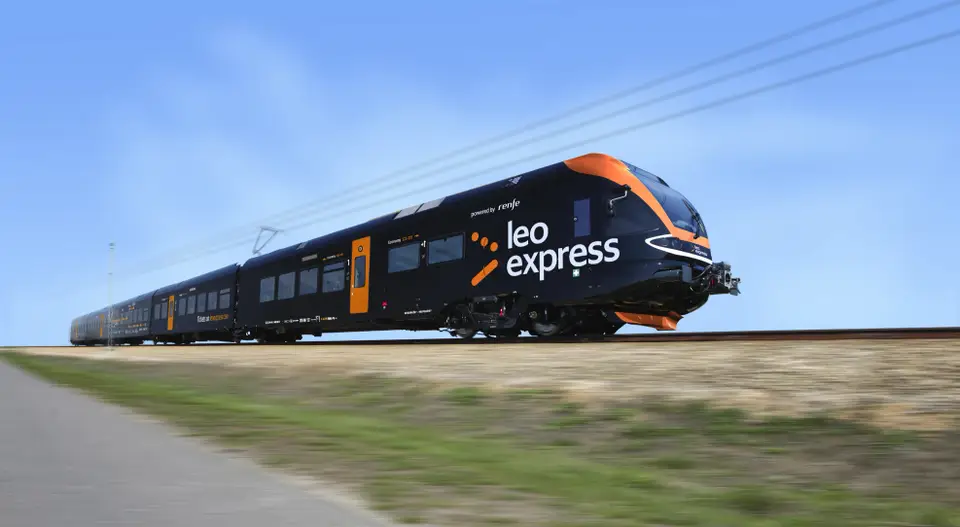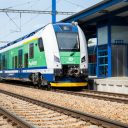With Czechia and Slovakia slowly replacing the traction system of their rail networks – meaning seamless travel across the different electrification standards – the Czech government has given private operator Leo Express a big subsidy to update their fleet. That’s after the traction upgrade saw cuts to their services. Leo has thus decided on Stadler to deck its FLIRT fleet out with the additional traction components – with the contract worth 16 million euros.
Czechia and Slovakia – once joined at the hip – have slowly been modernising their railway systems in recent years by switching the power supply used by their trains, introducing dual-traction compatibility to their networks. This involves upgrading infrastructure to replace the older 3,000-volt direct current (DC) system with the more modern and widely adopted 25,000-volt alternating current (AC) system, which is the European standard.
The shift is critical because many European countries already use the AC system, so the switch means better interoperability for both countries’ networks; essentially, trains can operate across their borders without interruptions. Indeed, in July 2022, Czech infrastructure manager Správa Železnic completed the first conversion of a railway section from DC to AC, making the change between the key Nedakonice and Říkovice on the Břeclav–Přerov corridor.
A milestone for some, a hurdle for others
The milestone marked the beginning of the broader 94-million-euro initiative to unify the country’s electrification system, which was essentially all good news: a more efficient power supply, reduced energy losses, and better compatibility with high-speed lines. However, not everyone was a winner; the switch to AC meant that private rail operators like Leo Express, whose trains were incompatible with the new system, had to axe certain parts of their routes.
To compensate, it had to add more trains on the Prague-Bohumín route to make up for routes they could no longer operate due to the upgrade. But the loss of business represented a serious hit that needed to be compensated for.
Thus, in the meantime, Leo Express CEO Peter Köhler and Renfe’s Chairman Raül Blanco – the Spanish state-backed operator that acquired a 50 per cent stake in Leo in 2021 – in 2023 agreed on plans for the joint expansion of their operations in Central Europe, “with a view to taking a leap in their activity in the short term and growing up to 80 per cent.” For Leo, the ‘short-term’ boost, outside of a wider business plan, made sense for obvious reasons.
Subsidy for Leo Express FLIRT upgrade
However, more than two years on, the private operator is finally able to envisage getting its trains back on the tracks in Slovakia and Czechia where their rolling stock had previously been left defunct; with the help of a Czech transport ministry subsidy, they are updating their FLIRT fleet to be able to run on both traction systems. And Stadler, who manufactured the rolling stock in the first place, is taking care of the upgrades.
“Thanks to dualisation, the Leo Express trains will be able to operate on both alternating current and direct current, enabling us to expand our services,” said Peter Köhler, CEO of Leo Express in a statement. “The Ministry of Transport has awarded us a subsidy covering approximately 40 per cent of the 16-million-euro investment, for which we are very grateful. Furthermore, we received the highest rating among all applications submitted in the subsidy call.”
The contract specifics
The contract will see Stadler upgrade the five-car FLIRTs with 25kV/50Hz traction, supplementing the 3kV traction, which the trains were already equipped with. The work will be carried out at Stadler’s plant in Frauenfeld in north-east Switzerland, with Czech suppliers, including AŽD Praha and VUZ Velim, to be involved in the contract.
Replacing the hardware will see the 25kV system integrated into the FLIRTs’ Train Control and Management System (TCMS), which centrally monitors, controls, and manages the trains’ various subsystems, including propulsion, braking, and passenger information. The diagnostic system will also be upgraded, and a control element for switching between the two traction systems will be added. As part of the process, there will also be a weight assessment, a body strength test, and a technical running and brake test.
All this essentially means that in the future the trains will be able to operate on both types of electrical infrastructure, allowing them to run on all parts of the networks in Czechia and Slovakia, as well as on the networks they serve in Poland. Essentially, Leo Express’s long wait has paid off – and for Stadler as well.
Read more:
Want full access? Take advantage of our exclusive offer
Are you already a subscriber?


